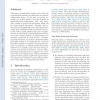Free Online Productivity Tools
i2Speak
i2Symbol
i2OCR
iTex2Img
iWeb2Print
iWeb2Shot
i2Type
iPdf2Split
iPdf2Merge
i2Bopomofo
i2Arabic
i2Style
i2Image
i2PDF
iLatex2Rtf
Sci2ools
SCIENTOMETRICS
2010
2010
Academic team formation as evolving hypergraphs
This paper quantitatively explores the social and socio-semantic patterns of constitution of academic collaboration teams. To this end, we broadly underline two critical features of social networks of knowledge-based collaboration: first, they essentially consist of group-level interactions which call for team-centered approaches. Formally, this induces the use of hypergraphs and n-adic interactions, rather than traditional dyadic frameworks of interaction such as graphs, binding only pairs of agents. Second, we advocate the joint consideration of structural and semantic features, as collaborations are allegedly constrained by both of them. Considering these provisions, we propose a framework which principally enables us to empirically test a series of hypotheses related to academic team formation patterns. In particular, we exhibit and characterize the influence of an implicit group structure driving recurrent team formation processes. On the whole, innovative production does not app...
| Added | 21 May 2011 |
| Updated | 21 May 2011 |
| Type | Journal |
| Year | 2010 |
| Where | SCIENTOMETRICS |
| Authors | Carla Taramasco, Jean-Philippe Cointet, Camille Roth |
Comments (0)

